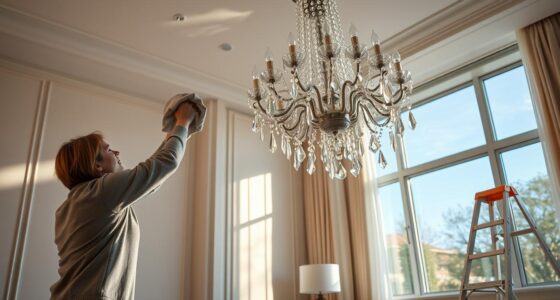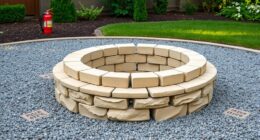When choosing doors for your furnace closet, consider functionality first. You'll want to guarantee proper airflow for your HVAC system's efficiency. Louvered or vented steel doors can help maintain ventilation, while solid doors are suitable for sealed combustion units. Space is essential, so options like bifold or sliding doors work well in tighter areas. Always check door height; maintaining at least 48 inches is important for access during maintenance. Custom solutions can enhance both aesthetics and efficiency. For more insights into optimizing your space and guaranteeing system performance, you'll want to explore further options and recommendations.
Key Takeaways
- Select louvered doors for furnace closets to ensure proper airflow and enhance HVAC system efficiency.
- Consider bi-fold or pocket doors for limited spaces, providing easy access without compromising room aesthetics.
- Ensure compliance with local building codes by using vented steel doors for open fire boxes.
- Choose solid doors for sealed combustion units, balancing safety with an aesthetically pleasing design.
- Evaluate the door height and configuration to maintain HVAC functionality and indoor air quality.
Door Height Considerations
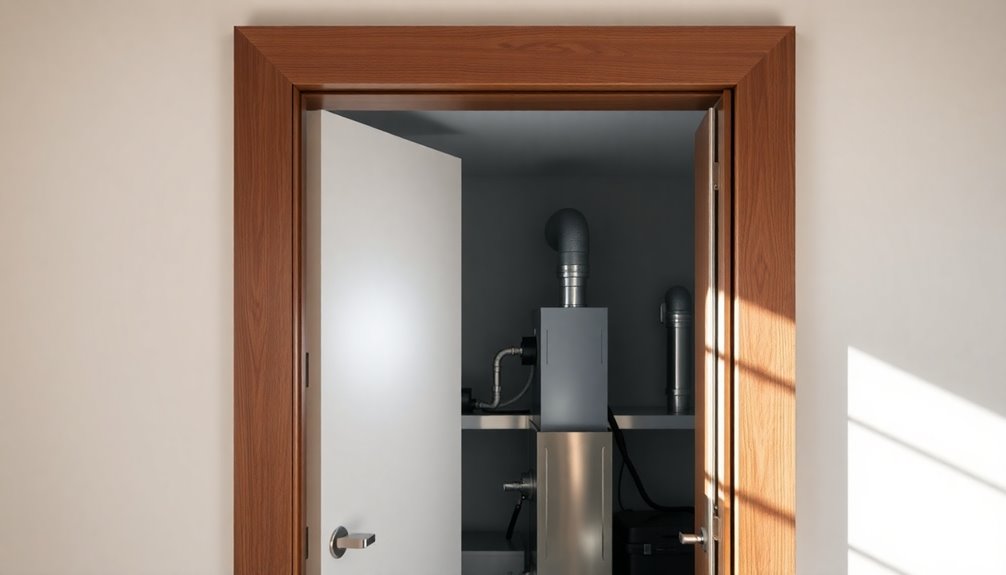
When considering door height for furnace closets, it's vital to keep both access and aesthetics in mind.
The current door height of about 48.5 inches meets the minimum requirement of 48 inches, but you might think about lowering it by an inch for a more streamlined look.
However, be careful—this could create access issues for HVAC contractors during maintenance or inspections. Maintaining adequate access is essential, as any alteration might complicate servicing your HVAC system.
You should also consider the limitations set by the original house design from the 1980s. Instead of reducing door height, you could explore options like raising adjacent doors or adding trim to achieve aesthetic consistency while ensuring functionality for your HVAC needs.
HVAC System Configuration
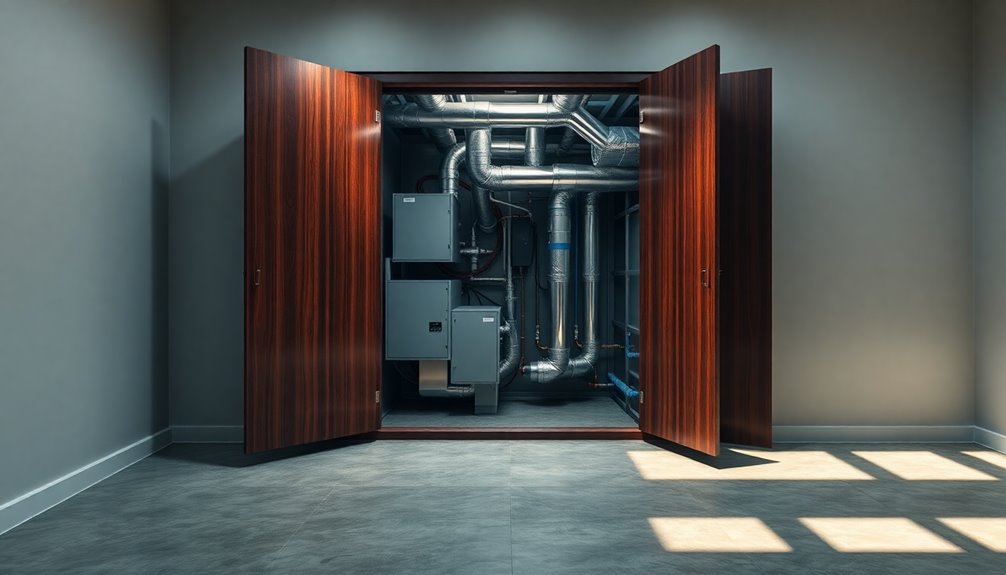
While your HVAC system's configuration plays an essential role in overall efficiency, it's important to understand how the components interact within the constraints of your furnace closet.
With a 3.5-ton electric AC and furnace unit, you'll need to take into account how doors and ventilation design impact airflow. The two return air paths—one below the door and another in the adjacent bedroom—affect the system's performance and could lead to inefficiencies, especially with blower noise.
Although your system is electric, ensuring proper ventilation is critical for maintaining air quality.
The 1980s house design may present limitations, particularly in how doors function due to pressure issues, so keep these factors in mind when choosing doors for your HVAC closet.
House Design Limitations
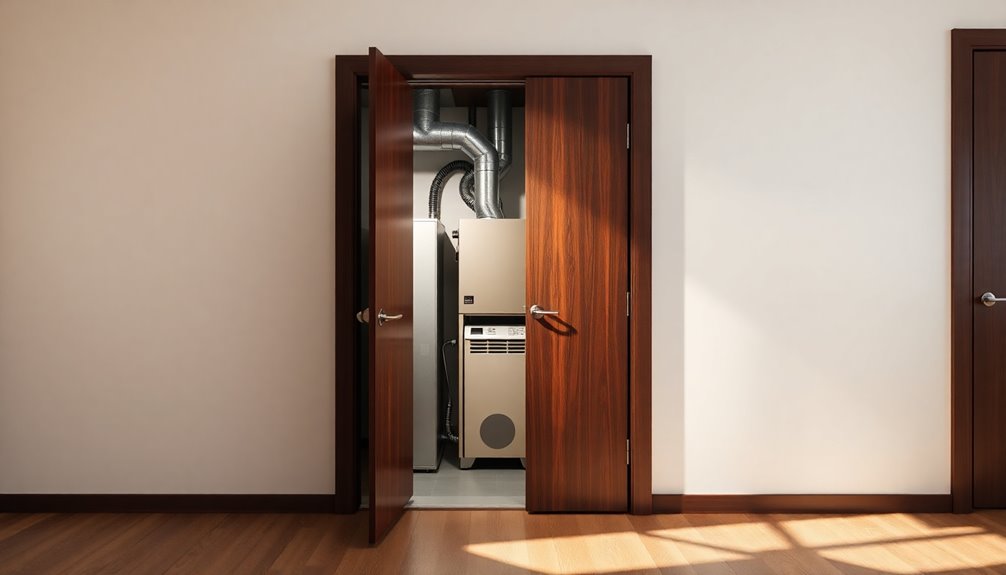
The limitations of 1980s house design can greatly impact HVAC efficiency, especially concerning furnace closets. Outdated layouts often restrict air flow, making it difficult for modern systems to perform effectively.
You might find that space constraints prevent the installation of additional return vents, leading to pressure issues that affect door functionality. For instance, your bedroom door may not close fully when the AC runs, disrupting comfort.
Additionally, original design choices could force you to keep closet doors open for better air flow, compromising your home's aesthetics.
Types of HVAC Closet Doors
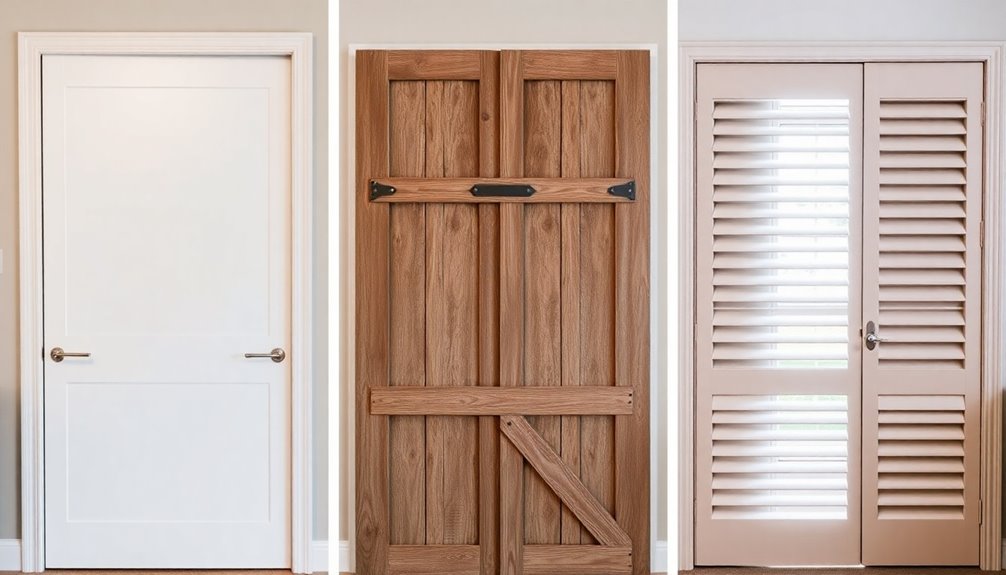
Choosing the right door for your HVAC closet can greatly impact both functionality and aesthetics.
Bifold doors are a popular choice since they save space and provide easy access in tight areas. If you're working with narrow spaces, sliding doors offer smooth operation without needing extra clearance for swing.
For a sleek and modern look, flush doors effectively conceal HVAC systems while enhancing the room's overall design.
Louvered doors are excellent for ventilation, allowing airflow essential for your system's efficiency, and they also add a stylish touch.
Finally, accordion doors are versatile and adapt to various closet sizes, offering flexible access solutions for your HVAC installation.
Selecting the right type of closet doors can greatly improve your space.
Recommendations for Door Selection
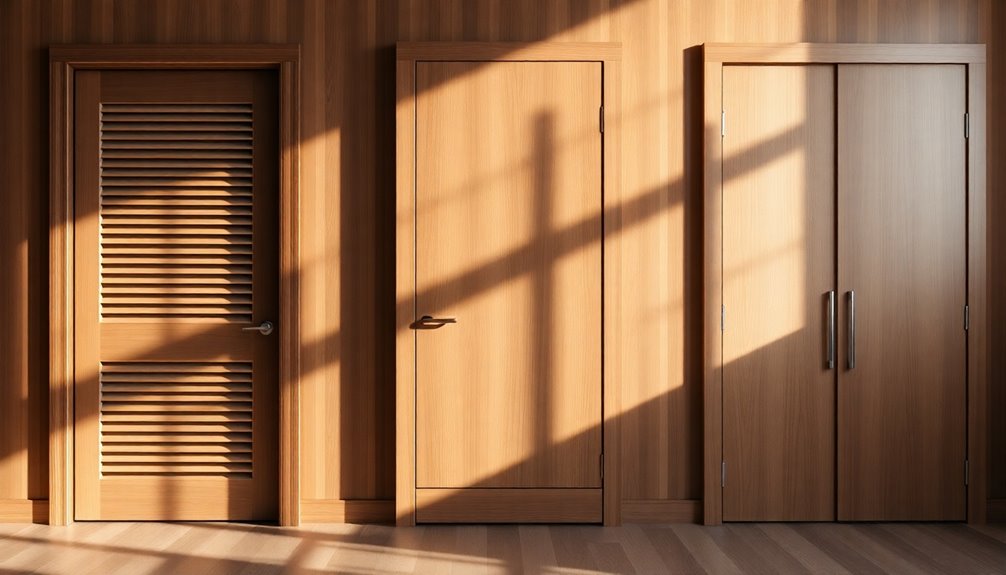
When selecting doors for your furnace closet, it's crucial to take into account both functionality and compliance with local building codes.
The type of furnace you have will influence your door choice markedly. Here are some recommendations to contemplate:
- Vented Steel Doors: Required for open fire boxes to guarantee proper ventilation.
- Solid Doors: Suitable for sealed combustion units, offering a clean look without compromising safety.
- Airflow Design: Confirm the door allows adequate airflow for efficient furnace operation.
- Custom Solutions: Reflect on bi-fold or pocket doors to optimize space while maintaining easy access for maintenance.
Additionally, ensuring proper ventilation is essential to maintain air quality standards within your home.
Frequently Asked Questions
What Kind of Door Do I Need for a Furnace Room?
When you're selecting a door for your furnace room, you need to take into account safety and ventilation first.
Typically, vented steel doors are your best bet, as they comply with building codes and guarantee proper airflow.
However, if you have a sealed combustion unit, a hollow core door might suffice.
Always check your local building codes before making a decision, as they dictate the requirements for materials and venting in furnace rooms.
Do Closet Doors Need to Match Other Doors?
No, closet doors don't have to match other doors in your home.
You can choose different styles or materials that suit the space's function and your personal taste. While matching doors can create a cohesive look, unique designs might be more practical and visually interesting.
Consider your design goals and any local building codes that might affect your choices. Ultimately, it's about balancing style with functionality to fit your needs.
What Is the Trend in Closet Doors?
When it comes to closet doors, you'll notice a charming shift towards functionality and style.
You'll find bi-fold and pocket doors making a grand entrance, maximizing your space while ensuring easy access.
Louvered doors remain a favorite, offering that much-needed ventilation.
Custom designs are all the rage, fitting unique dimensions beautifully.
Plus, durable materials and stylish finishes are taking center stage, blending seamlessly with your home decor while serving practical purposes.
Should a Furnace Room Door Open in or Out?
You should opt for a furnace room door that opens outward.
This design not only provides easier access for maintenance but also prevents obstructions during emergencies. Outward-opening doors enhance airflow and ventilation, which is essential for your HVAC system's efficiency.
Additionally, many building codes require these doors to swing outward for safety and compliance.
If space is tight, consider bi-fold or pocket doors that still allow for this important outward-opening function.
Conclusion
When choosing the right door for your furnace closet, it's essential to take into account height, HVAC layout, and your home's design. Did you know that nearly 70% of homeowners overlook the importance of proper ventilation when selecting these doors? By keeping airflow in mind and selecting the right type, you can enhance your HVAC system's efficiency and longevity. So, take the time to choose wisely—it'll pay off in comfort and savings down the line!





